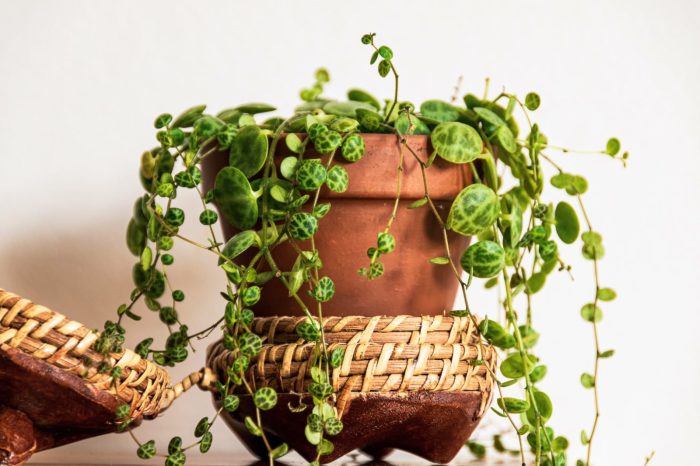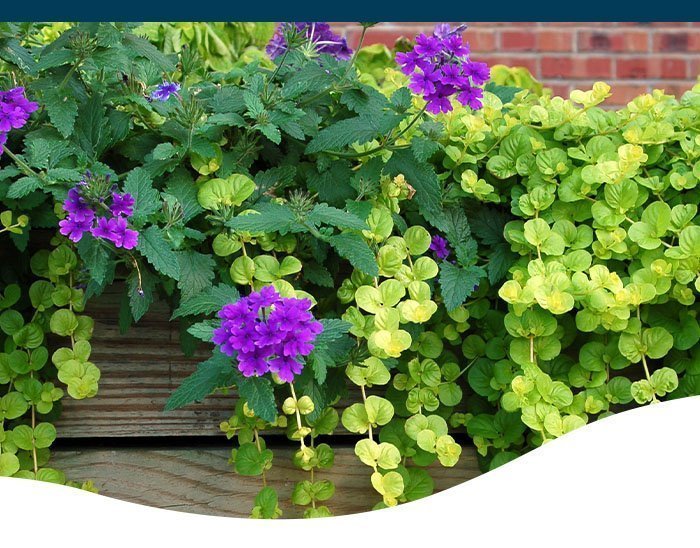Small trailing plants, with their graceful vines and cascading foliage, add a touch of elegance and charm to any space. From lush indoor gardens to vibrant outdoor displays, these versatile plants offer a wide range of options for gardeners of all levels.
In this comprehensive guide, we delve into the world of small trailing plants, exploring their diverse species, specific care requirements, and inspiring design ideas. Whether you’re a seasoned plant enthusiast or just starting your green journey, this article will provide you with everything you need to know to cultivate and enjoy these captivating plants.
Small Trailing Plant Species
Trailing plants, with their graceful cascades and lush foliage, add a touch of elegance and charm to any space. Their compact size and adaptability make them ideal for a wide range of environments, from cozy indoor corners to sprawling outdoor gardens.
This comprehensive guide explores the diverse world of small trailing plants, providing detailed insights into their unique characteristics, growth habits, and suitability for various settings.
Botanical Varieties and Characteristics
The realm of small trailing plants encompasses a vast array of botanical species, each boasting distinct foliage, growth patterns, and flowering periods. Here’s an in-depth look at some of the most popular varieties:
- Creeping Jenny (Lysimachia nummularia):With its bright yellow foliage and creeping growth habit, Creeping Jenny forms dense mats that cascade beautifully over edges and containers.
- Baby’s Tears (Soleirolia soleirolii):This delicate plant features tiny, rounded leaves that resemble teardrops. It forms a dense, moss-like carpet that adds a touch of whimsy to terrariums and hanging baskets.
- String of Hearts (Ceropegia woodii):As its name suggests, this trailing succulent displays heart-shaped leaves with intricate patterns. Its long, trailing stems create a captivating effect.
- Spider Plant (Chlorophytum comosum):Spider Plants are known for their long, arching leaves with variegated patterns. They produce plantlets that dangle from the stems, adding an extra layer of interest.
- Swedish Ivy (Plectranthus australis):Featuring scalloped, velvety leaves in shades of green and silver, Swedish Ivy is a popular choice for hanging baskets and indoor containers.
Care and Maintenance

Providing proper care and maintenance is crucial for thriving small trailing plants. These plants have specific requirements for lighting, watering, soil, pruning, and pest management.
Lighting
Most trailing plants prefer bright, indirect light. Avoid direct sunlight, as it can scorch the leaves. Some varieties can tolerate lower light conditions, but their growth may be slower.
Watering
Water when the top inch of soil feels dry to the touch. Avoid overwatering, as it can lead to root rot. Use room-temperature water and allow excess water to drain from the pot.
Small trailing plants, with their graceful cascades and lush greenery, add a touch of natural elegance to any indoor space. Whether suspended in indoor hanging baskets or cascading over shelves, these plants bring a sense of tranquility and freshness to any room.
Their delicate tendrils and cascading foliage create a visually appealing effect that complements any décor style, making them a popular choice for both homes and offices.
Soil, Small trailing plant
Trailing plants prefer well-draining, organic-rich soil. A mixture of potting soil, perlite, and compost provides optimal aeration and moisture retention.
Pruning
Regular pruning encourages healthy growth and prevents legginess. Remove any dead or damaged stems, and trim back overgrown vines to promote bushier growth.
Pest Management
Trailing plants are susceptible to pests such as mealybugs, aphids, and spider mites. Inspect plants regularly and treat infestations promptly with insecticidal soap or neem oil.
Design Ideas and Applications

Small trailing plants are not just visually appealing but also versatile in their applications. They can add a touch of greenery and vibrancy to any space, whether indoors or outdoors.
In interior design, trailing plants can be used to create vertical gardens and living walls, bringing nature indoors and improving air quality. They can also be suspended from ceilings or placed on shelves to create a cascading effect.
Vertical Gardens
Vertical gardens are a great way to maximize space and add greenery to small apartments or offices. Trailing plants, such as pothos, ivy, and philodendron, are ideal for this purpose as they can grow upwards and cover large areas with their lush foliage.
Living Walls
Living walls are similar to vertical gardens but are typically larger and more permanent. They can be installed in both indoor and outdoor spaces and are a great way to add a touch of nature to urban environments.
Hanging Displays
Trailing plants can also be used to create beautiful hanging displays. They can be suspended from ceilings, balconies, or porches, adding a touch of greenery and elegance to any space.
When combining trailing plants with other plants or decorative elements, it is important to consider their size, shape, and color. For example, trailing plants can be paired with larger plants to create a layered effect, or with bright flowers to add a pop of color.
DIY Projects and Crafts

Small trailing plants offer ample opportunities for creative DIY projects and crafts, adding a touch of greenery and personal flair to your living space. From hanging planters to macrame plant hangers and living wall frames, there’s a project to suit every skill level and aesthetic preference.
Hanging Planters
Create charming hanging planters using twine, macrame cord, or yarn. Wrap the material around a wire ring or bamboo hoop, securing it with knots or glue. Insert a small trailing plant in a plastic or ceramic pot and hang it inside the planter.
Experiment with different hanging styles, such as macrame knots or braided cord, to add a unique touch.
Macrame Plant Hangers
Macrame plant hangers are a stylish and bohemian way to display small trailing plants. Follow a macrame pattern or experiment with your own designs using cotton or jute cord. Create a series of knots to form the hanger and attach a ring or hook to hang the plant.
Personalize the hanger with beads, tassels, or other decorative elements.
Living Wall Frames
Transform a wall into a living masterpiece with a DIY living wall frame. Build a frame from wood or PVC pipes and attach a grid or wire mesh to the back. Fill the frame with small trailing plants in individual pots or create a moss-lined wall with plants tucked into crevices.
Use a variety of plants with different colors and textures to create a vibrant and eye-catching display.
Health Benefits and Uses
Small trailing plants offer a range of potential health benefits, both physical and mental. Studies have shown that these plants can help purify the air by removing toxins and increasing humidity, creating a healthier indoor environment. Additionally, the presence of greenery has been linked to stress reduction, improved mood, and enhanced cognitive function.
Traditional and Modern Uses
In traditional medicine, small trailing plants have been used for centuries to treat a variety of ailments. For example, ivy is known for its expectorant and anti-inflammatory properties, while spider plants are believed to have air-purifying and mood-boosting effects. In modern aromatherapy, essential oils derived from trailing plants are used to promote relaxation, reduce anxiety, and improve sleep quality.
Small trailing plants, often used to add a touch of greenery to shelves and tables, can also be a beautiful addition to hanging house plants . Their long, cascading stems can create a dramatic effect, adding movement and interest to any room.
Trailing plants are relatively easy to care for, making them a great choice for busy individuals or those new to gardening.
Cultural Significance
In different cultures around the world, small trailing plants hold significant cultural and symbolic meanings. In China, for instance, ivy is associated with longevity and good luck, while in Japan, spider plants represent happiness and prosperity. In some Native American traditions, trailing plants are believed to have spiritual significance and are used in rituals and ceremonies.
Final Thoughts
Small trailing plants offer endless possibilities for creating beautiful and functional spaces. With their versatility and adaptability, they can transform any environment into a lush and inviting oasis. Whether you’re looking to purify the air, reduce stress, or simply add a touch of greenery to your surroundings, these charming plants are sure to captivate and inspire.
Clarifying Questions: Small Trailing Plant
What are the most popular small trailing plant species?
Some of the most popular small trailing plant species include English ivy, creeping Jenny, spider plant, Swedish ivy, and pothos.
How often should I water my small trailing plant?
Water your small trailing plant when the top inch of soil feels dry to the touch. Avoid overwatering, as this can lead to root rot.
Can small trailing plants tolerate full sun?
While some small trailing plants can tolerate full sun, most prefer partial shade or indirect sunlight.